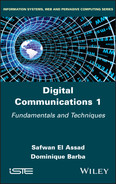References
- Assaf, R., El Assad, S., Harkous, Y. (2010). Simulation et égalisation adaptative des canaux de transmission. Éditions universitaires européennes, Nantes.
- Barba, D. (2019). Cours de théorie et transmission de l’information. Polytech, Nantes.
- Baudoin, G. (2002). Radiocommunications numériques 1. Dunod, Paris.
- Bic, J.C., Duponteil, D., Imbeaux, J.C. (1986). Eléments de communications numériques. Dunod, Paris.
- Caragata, D., El Assad, S., Luduena, M. (2015). An improved fragile watermarking algorithm for JPEG images. International Journal of Electronics and Communications, 69, 1783-1794.
- Charbit, M. (2003). Systèmes de communications et théorie de l’information. Hermes-Lavoisier, Cachan.
- Combes, P.F. (1996). Micro-ondes: lignes, guides et cavités, cours et exercices. Dunod, Paris.
- Csillag, P. (1990). Introduction aux codes correcteurs. Ellipses, Paris.
- De Cannière, C. and Preneel, B. (2006). Trivium specifications [Online]. Available at: http://www.ecrypt.eu.org/stream/p3ciphers/trivium/trivium_p3.pdf.
- Dixon, R.C. (1994). Spread Spectrum Systems with Commercial Applications. John Wiley & Sons, Hoboken.
- El Assad, S. (2001). Conception et simulation d’un modem MDP-8 cohérent et différentiel. International Conference on Image and Signal Processing, ICISP 2001, Agadir, 845-852.
- El Assad, S. (2019). Cours de communications numériques: bases et techniques. Polytech, Nantes.
- El Assad, S. and Barba, D. (2020). Communications numériques 2: travaux dirigés et pratiques. ISTE Éditions, London.
- El Assad, S., et al. (2003-2005). COBBALT: coopération ouest BAL en télécommunications. Internal report, Université virtuelle en Pays de la Loire.
- El Assad, S., et al. (2006-2008). MASTER-FOAD, projet UVPL. Internal report, Université virtuelle en Pays de la Loire.
- Fontolliet, P.G. (1983). Systèmes de télécommunications. Dunod, Paris.
- Glavieux, A. and Joindot, M. (1996). Communications numériques. Masson, Paris.
- Guglielmi, M. (2004). Signaux aléatoires: modélisation, estimation, détection. Hermes-Lavoisier, Paris.
- Haykin, S. (1988). Digital Communications. John Wiley & Sons, Hoboken.
- MacWilliams, F.J. and Stoane, N.J.A. (1977). The Theory of Error Correcting Codes. Bell Laboratories, Murray Hill.
- MathWorks (2020). comm.KasamiSequence [Online]. Available at: https://fr.mathworks.com/help/comm/ref/comm.kasamisequence-system-object.html.
- Maximov, A. and Biryukov, A. (2007). Two trivial attacks on Trivium. In Selected Areas in Cryptography, Adams, C., Miri, A. and Wiener, M. (eds). Springer-Verlag, Berlin.
- Paar, C. and Oelzl, J. (2010). Understanding Cryptography. Springer-Verlag, Berlin.
- Patzold, M. (2002). Mobile Fading Channels. John Wiley & Sons, Hoboken.
- Penaud, S. (2001). Etude des potentialités du chaos pour les systèmes de télécommunications: évaluation des performances de systèmes à accès multiples à répartition par les codes (CDMA) utilisant des séquences d’étalement chaotiques. Thesis, University of Limoges.
- Proakis, J.G. (1995). Digital Communications. McGraw-Hill, New York.
- Roubine, E. (1970). Introduction à la théorie de la communication III. Masson, Paris.
- Sanchez, J. and Thioune, M. (2008). UMTS, 3rd edition. Hermes-Lavoisier, Cachan.
- Servin, C. (2009). Réseaux & télécoms. Dunod, Paris.
- Sklar, B. (1988). Digital Communications. Prentice Hall, Upper Saddle River.
- Spataru, A. (1987). Fondements de la théorie de la transmission de l’information. Presses polytechniques et universitaires romandes, Lausanne.
- Stein, M. (1991). Les modems pour transmission des données. Masson, Paris.
- Tomasi, W. (1998). Electronic Communications Systems. Prentice Hall, Upper Saddle River.
- Webb, W. and Hanzo, L. (1994). Modern Quadrature Amplitude Modulation. Pentech Press, London.
..................Content has been hidden....................
You can't read the all page of ebook, please click here login for view all page.
